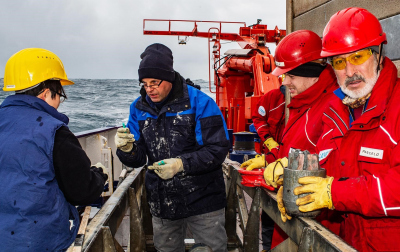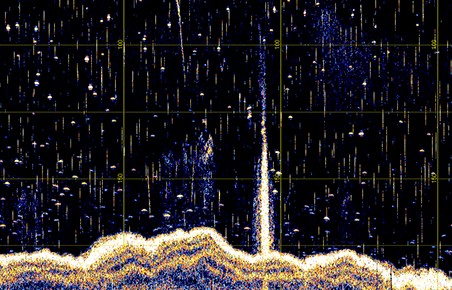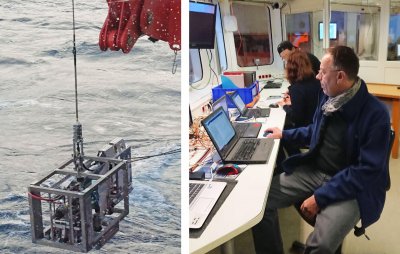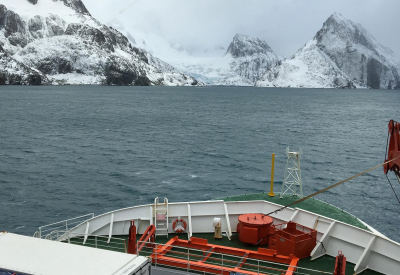- Home
- Research
- Expeditions
- 2019
- PS119
- PS119 – 2nd Weekly Report
South Georgia – Gate to Antarctica
PS119 – 2nd Weekly Report, 16. – 22.4.19
After the departure from Punta Arenas and an 8-hour passage through the Magellan Strait, RV Polarstern started a 4-day transit bound for South Georgia. This time without station work was used by our 51 scientists from Germany, USA, Costa Rica, Austria, UK, Bosnia & Herzegovina, Chile, Taiwan, France, India, Slovenia, Spain and Switzerland to further set up laboratories and to intensely exchange talks on the various research aims of this expedition. Every day, lectures were given between afternoon coffee break and dinner, which introduced discussions into the subjects relevant to this expedition.
RV POLARSTERN steamed over the wide Argentine continental shelf eastwards, and after about two days, we reached deeper water depths of more than 3,000 meters in the Falklands Trough, an elongated groove separating the Falkland Plateau from Burdwood Bank and the northern Scotia Ridge. After crossing the shallow North Scotia Ridge, which rises to shallower than 1,000 meters water depth, we started our bathymetric and sediment-profiling surveys with the vessel’s own hydro-acoustic Hydrosweep and Parasound systems in the Scotia Sea. We selected our transit line to the East by choosing a course to cover yet uncharted seafloor areas, in order to contribute to the close still significant gaps in the seafloor surveys of this region.
After we reached on our forths day, Friday 19th April, the deep-sea area to the South-West of South Georgia, very early on Saturday morning we started the Parasound survey of the sediment waves. These sediment waves, which are thought to have formed through bottom currents, document through high sedimentation rates the paleoceanography of the Antarctic Circumpolar Current and were therefore chosen as targets for sampling. We sampled these structures via two gravity corer and one multi-corer deployment throughout Saturday despite a lively sea state and winds of 6 to 7 on the Beaufort scale.
Multi-proxy examinations at the AWI on these sediment cores shall deliver new knowledge on the temporal variability of the surface and seafloor circulation during the last orbital climate cycle. The oceanographic regions around South Georgia are of special interest for paleoceanography because of the possibility of iron influx and a linked raised primary productivity. On Sunday, 21st April, the weather was to brighten and calmed down, and we planned our first dive with the MARUM ROV QUEST to dive at Paradise Flare and investigate a gas emission site (Fig. 2). Paradise Flare had been discovered in the course of hydro-acoustic surveys of the water column during RV Meteor Expedition M134 in 170 m water depth in 2017, but bad weather had stopped a closer investigation.
Again, weather conditions on Sunday and Monday denied us the chance of a detailed investigation of the site. But we were able to use the new multi-function sled OFOBS of the AWI deep-sea group at the location and next to an optical assessment in the neighborhood of Paradise Flare do a bathymetric survey of the seafloor with the sled’s side-scan sonar.
In the afternoon of Easter Sunday we steamed into Drygalski Fjord, which is penetrating deep into the island at the south-easterly end of South Georgia. While the entrance to the fjord is 2 km wide, it narrows to just about 800 meters width, and from board of RV POLARSTERN, one had a fantastic view to the steep mountain sides, the glaciers, and onto the geological formations formed by the oldest rocks of South Georgia. Right in the middle of the fjord, we took a sediment core within a tightly confined basin, whose chemical signature is of special interest to our geochemists. The sampling was a success. The evening of Easter Sunday was celebrated with a BBQ on the working deck and in the working deck-level, inner cargo hold of RV POLARSTERN.
Unfortunately, Easter Monday, 22nd April, was as expected, still too stormy to proceed with our first dive at Paradise Flare. Therefore, we used the day for a series of sediment cores by gravity corer in various sub-basins of the Drygalski trough and by a multi-corer with 12 shorter sediment cores. Thick sediment layers in some of the fjords and glacially eroded troughs of South Georgia have exceptionally well archived recent glacier behavior and climate change. The sub-polar ice-cap on South Georgia reacts more sensitive to climatic changes than the much larger and more isolated Antarctic ice shelves and are therefore a central target for studies on sediment cores to better understand the climate variations in the Southern Hemisphere.
Unfortunately, the weather system will only allow us commence the first dive earliest on Wednesday, and therefore we decided to use the Tuesday to steam to the East Scotia Ridge, to start our diving there on the hydrothermal vents of the ridge segment E2. A westerly wedge of a high pressure system lying to the North will reach us and is promising a few calmer days, which we want to use for ROV dives.
Apart from a few scientists sharing a mild cold, everybody else is fine.
Best regards in the name of all participants,
Gerhard Bohrmann, RV POLARSTERN, Monday, 22nd April 2019






